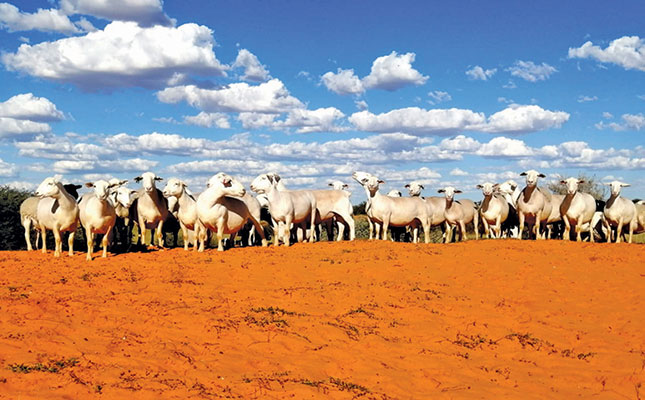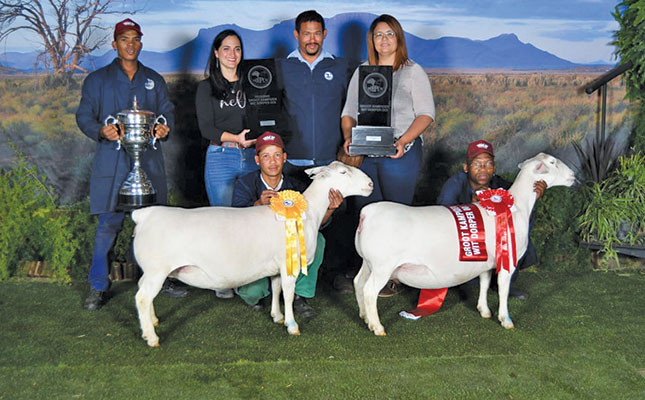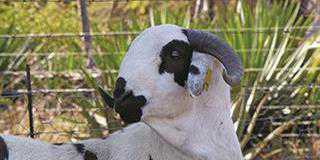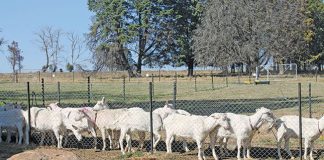
Photo: Supplied
Larry Snyders’s story begins with an experience sickeningly familiar to many South Africans: retrenchment. In 2016, he was one of 2 500 individuals who lost their jobs at Kumba Iron Ore.
“This forced me to relook at my career. I decided to focus full time on my sideline business, my small White Dorper stud. I haven’t regretted the decision for a single moment.”
It’s not hard to understand why. Earlier this year, Snyders was crowned the Breeder of Champions at the biennial Dorper World Championship Show, which took place in May. His stud produced the Grand Champion Ewe and the Reserve Grand Champion, amongst others.
This is no mean feat, considering that 1 200 animals from 39 studs from across the country took part in the competition.
Struggles with government
In the year after his retrenchment, Snyders got a lucky break: he managed to obtain a 25-year lease from government for the farm Vooruitsig, an 8 000ha property in the Van Zylsrus district of the Northern Cape. The farm receives between 250mm and 300mm of rainfall annually and has mixed Kalahariveld with grasses such as tall bushman grass (Stipagrostis ciliata) and gha grass (Centropodia glauca).
Over the past six years, Snyders has expanded his farming activities. In addition to the White Dorper stud, he now has a commercial Dorper herd and a commercial herd of Bonsmara-type cattle.
It has certainly not been plain sailing to come to this point. Snyders says that though he was grateful for the opportunity to lease land from government, the state turned out to be a rather poor landlord.
“I’m one of two beneficiaries on the land and government was therefore supposed to divide the land in two. However, the water infrastructure and fencing that they erected weren’t up to standard and this has caused us real harm.”
To this day, water remains an issue, as underground leakages lead to sky-high water bills, which have to be footed by Snyders.
In addition, the lack of proper fencing has meant that he was unable to yield a good harvest in the first two years due to predation from jackal and caracal.
Snyders said that although he often brought in professional hunters, he was simply unable to beat the predators due to poor fencing.
“I often contacted the Department of Agriculture, Land Reform and Rural Development in the hope that they’d help me by fixing the outer fencing, but they didn’t do anything other than make empty promises.”
Snyders eventually tried the Upington municipality, as it owned his neighbouring farm, but here, too, he received no assistance.
“I realised then that it was up to me to take care of my animals and my future, as nobody else was going to help me.”
He decided to take a gamble and use money set aside for his debts to pay for fence repairs.
“I also established smaller camps closer to the house for the ewes.”
Snyders placed 600mm of underground mesh on 10km fencing and increased the fence’s height from 1,2m to 1,5m. He also put power cables on both sides of the fence with a third power cord over it.
“The entire exercise cost me R400 000 and I subsequently started falling behind on my Land Bank and water accounts,” he recalls.
This, unfortunately, had a negative effect on his credit score, which made it difficult to sustain his animals properly.
“It was a dry period and I wasn’t able to supply [enough] feed or licks for the animals. But at least I could keep the ones that survived alive.”
Snyders informed the department that he had fixed the fences himself. In reply, he was told that he was not allowed to carry out this sort of repair on his own, and that the department would not reimburse him.
“I didn’t want the money back. I just wanted some help, because there was still a lot of repair work that needed to be done and I couldn’t do it all myself. Still, it all just fell on deaf ears.”
With this unpleasant experience behind him, and his sheep now protected, Snyders began to see an increase in his lamb harvest.
“Honestly, it made all of my inputs worthwhile and I’m not sorry in the least,” Snyders says.
Stud development
Snyders had come to a point where he could now focus on creating his ideal stud. “The White Dorper Stud consists of 70 ewes and I can recognise each by simply looking at her face. I know exactly how each of them breeds and we don’t keep any ewe that’s not pulling her weight.”
Snyders believes in quality over quantity and therefore prefers to keep fewer animals, so that he can invest in the best possible genetics to drive his flock forward. He uses his finest ewes in an embryo-flushing programme.
“In my opinion, this is the best way to move a stud forward, provided you use optimal pairings,” says Snyders. “For our Bloem Show team, we displayed, amongst other animals, three separate embryo lambs, which all came from a mother and daughter and were birthed by three surrogate ewes.”
Snyders buys in rams from far afield and is happy to use any stud that adheres to his standards.
Competitions
In 2018, he took part in his second SA Dorper show and took home first prize in the ram lamb under 45kg category. Since then, the awards have kept on rolling in. Snyders’s animals won four out of the 12 categories at last year’s Rustenburg Show and a number of awards at the 2022 Bloem Show in April and May.

“I was proudest of our achievement in the four-tooth ewe category. Here we took first, second and third place. And the ewe that came third was an animal that we didn’t receive a single bid on during our 5-Star Auction in Upington in March!”
For this auction sale, Snyders combines his production animals with those of three fellow stud breeders, Mickey, Leroy and Ashley Phillips.
As mentioned, Snyders’s finest achievement came during the Dorper World Championship in May, when ewes from his stud were crowned as the senior and reserve senior champions, and he received the award of breeder of champions. Snyders also made history as the first black farmer to emerge as breeder of champions (White Dorpers) in the history of the Dorper Sheep Breeders’ Society of South Africa.
Ready to learn more
Snyders is keenly aware of the need to improve his knowledge of the breed, and is more than willing to pass his knowledge on. In 2009, 2010 and 2011 respectively, he completed a week-long farm management course in Postmasburg under the watchful eye of then agricultural extension officer, Louis de Jager. (De Jager has since left the department to start the Kameelboom Academy, an Agri-SETA-accredited learning institution.)
Snyders thereafter took an assessor examination (in the process becoming the first black inspector in the history of the breed).
Having gained both practical experience and theoretical understanding, Snyders started sharing his knowledge with a number of developing farmers through active mentorship. In addition to helping them select the right genetics for their flocks, he has also helped several of them to register their studs.
Email Larry Snyders at [email protected].













